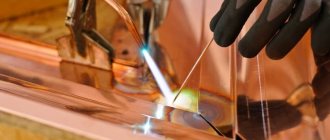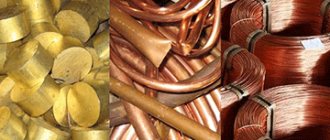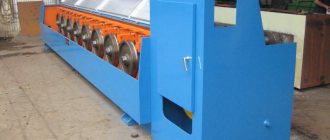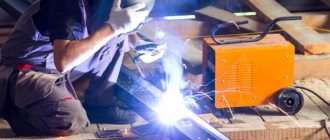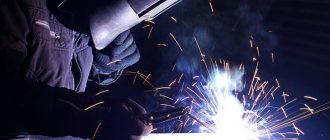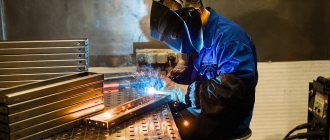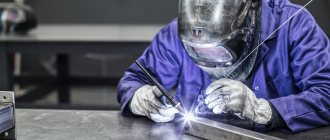What is the weldability of materials?
Physical weldability of metals is the property of materials to form a monolithic joint, i.e. their ability to mutually crystallize with the formation of solid solutions, chemical compounds and fine mixtures of phase components (eutectics). These processes occur at the boundary of the base and deposited metal and characterize weldability from the point of view of the possibility of forming a metallic bond and the fundamental possibility of obtaining permanent welded joints.
Technological weldability of metals is a technological characteristic of a metal that determines its response to the effects of welding and the ability to form a permanent welded joint with specified performance properties at the lowest cost. That is, it reflects the technological response of the material to the thermal, force and metallurgical effects of welding.
The weldability of a metal depends on its chemical and physical properties, the type of crystal lattice, the degree of alloying, the presence of impurities and a number of other factors.
The weldability of steels is assessed according to the following indicators:
- the tendency of the weld metal to form hot and cold cracks;
- tendency to change the structure in the heat-affected zone and to form hardening structures;
- physical and mechanical qualities of the welded joint (strength, ductility, impact strength, etc.);
- compliance of the special properties of the welded joint with the requirements of the technical specifications for the design (corrosion resistance, heat resistance, heat resistance, resistance to brittle fracture at low temperatures, etc.).
Simply put, the difference between materials with good and poor weldability is that more complex welding technology is required to join the latter.
Carbon has the greatest influence on the weldability of steels. Weldability deteriorates with increasing carbon content, as well as a number of other elements. For the manufacture of welded structures, structural low-carbon, low-alloy and alloy steels are mainly used. The main difficulties in welding alloy steels are their tendency to form hardening structures, hot and cold cracks, as well as deterioration of mechanical properties - primarily a decrease in ductility in the welded joint zone. The higher the carbon content in the steel, the more pronounced these disadvantages are, and the more difficult it is to ensure the required properties of the joint.
Approximate quantitative indicators of the weldability of steels are the equivalent carbon content, determined by the formula:
where the content of carbon and alloying elements is expressed as a percentage. Depending on the equivalent carbon content, structural steels are divided into 4 groups, which are characterized by satisfactory, limited or poor weldability.
Group 1: good weldability, SEQ ≤ 0.25%, weldability without the use of special techniques (st.2; st.3; 10G2; 09G2; 10G2S).
Group 2: satisfactory weldability, Sekv -0.25 - 0.35 - strict adherence to welding conditions, the use of special filler materials, in some cases - preliminary and concomitant heating to 100 - 1500 C, heat treatment are required (steels 15GS, 15 KhM, 10HSND , 14HGS, 15HSND, 15HGSA, 18G29).
Group 3: limited weldability, SEq - 0.35 - 0.45, requires heating to 100 - 2000 C and tempering after welding. Before welding, the parts are subjected to heat treatment (steels 12N1MF, 20KhMFL, 15Kh1M1FL, 30KhGS, 35G2, 30KhM, 10GN2MFA, 15Kh2NMFA).
Group 4: poor weldability, SEq > 0.45. High tendency to cold cracks in the weld and heat-affected zone. When welding, preheating to 250 - 4000C and subsequent heat treatment are required (steels 45Kh, 45G, 40G2, 40KhS, 40KhMFA, 35KhGSA, 30KhI3A, 40KhN2MA, 36Kh2R2MFA).
There is still no generally accepted method for determining the weldability of metals. In most cases, the techniques are based on welding special samples in which harsh conditions for the weld are created. However, there are also calculation methods that relate the maximum hardness and type of structure of the heat-affected zone of a given steel to the need to heat the part before welding, the design of the joint and the thickness of the metal. Calculation methods make it possible to theoretically calculate welding modes that ensure obtaining a given hardness and structure.
General concepts of weldability
Welding process
This is a complex of several simultaneously occurring processes, the main of which are: thermal effects on the metal in the heat-affected areas, melting, metallurgical processes, crystallization of the weld metal and mutual crystallization of metals in the fusion zone. Weldability refers to the ratio of metals to these basic processes. The weldability of metals is considered from a technological and physical point of view.
The thermal effect on the metal in heat-affected areas and the melting process are determined by the welding method and its modes.
The ratio of a metal to a specific welding method and mode is considered to be technological weldability. Physical weldability is determined by the processes occurring in the fusion zone of the metals being welded. These properties of metals characterize physical weldability.
The metals being welded can have the same or different chemical composition and properties. In the first case, these are metals that are homogeneous in chemical composition and properties, in the second case, they are dissimilar.
All homogeneous metals have physical weldability. The properties of dissimilar metals are never able to ensure the occurrence of the necessary physical and chemical processes in the fusion zone, therefore these metals do not have physical weldability.
Features of welding non-ferrous metals
During the phase transition process, light components evaporate and burn out, which has a detrimental effect on the condition of the seam. It's cracking. Refractory oxides are another problem. Sometimes it is necessary to increase the operating current to break through the oxide. When welding non-ferrous metals and alloys, the melt often becomes too fluid; it is necessary to isolate the melt pool. For some alloys, it is necessary to limit not only contact with oxygen, but also other components of the air. Nitrogen is not suitable as a protective atmosphere for some alloys.
Weld metal crystallization process
During crystallization, the metal of the weld pool is influenced by the hot welding arc and the cold surrounding metal. In other words, the arc introduces heat, and the metal of the product removes it.
The transition of a metal from a liquid to a solid state is accompanied by the formation of crystals - this is crystallization. The weld metal undergoes this process throughout the welding process.
The weld has the structure of cast metal. During welding, the edges of the workpiece and the electrode wire fed into the bath area melt. Conventionally, the latter consists of a front or head and tail part: in the first, melting occurs, and in the second, crystallization occurs and a seam is formed.
It is customary to distinguish between primary and secondary crystallization. Primary is the transition of liquid metal to a solid state, which is accompanied by the formation of crystals. At first, the resulting crystal grows freely and has the correct shape.
But since there is a parallel development of many crystals, they gradually begin to touch each other, and accordingly, the shape is disrupted. Eventually they become rounded, more like grains, which is why the crystals are referred to as grains.
The size of the grains depends on the progress of crystallization: they can be large, distinguishable without special equipment, and small. The latter are visible only under a microscope.
The crystalline structure of a metal or alloy is called structure. It is also customary to talk about the macrostructure or structure of metals, which can be distinguished with the naked eye or with the help of a magnifying glass.
Crystallization of weld metal occurs at a much higher rate than a similar process with ingots. This is explained by the fact that the intense heating of the weld pool is quickly replaced by heat removal into the workpiece.
Crystallization occurs in separate thin layers. When the first layer of crystals has formed, the cooling of the metal slows down against the background of the release of latent heat from the ongoing process. Then the second layer hardens, and so on throughout the bath.
Crystallization layers have a thickness from tenths of a millimeter to several millimeters - the specific indicator is determined by the volume of the weld pool and the characteristics of the heat sink. The columnar crystals of each new layer become a continuation of the previous one, due to which the crystals grow from layer to layer.
In order for the process of primary crystallization to start, its centers or nuclei must be formed, which will continuously grow. This role is played by the melted grains of metal found at the bottom of the weld pool.
Further, additional crystallization centers may appear - usually these are refractory particles, grain fragments, or centers spontaneously formed in the liquid metal.
During multilayer welding, the function of the centers falls on the crystals of the previous layer. They grow by attaching atoms from the surrounding liquid metal.
Each crystal is a group of elementary columnar crystals, one end of which is connected to a common base or fused grain of the base metal. Based on the shape and arrangement of the crystals, experts distinguish between granular, columnar and dendritic or tree-like structures of the cooled metal.
Works with magnesium
For magnesium parts, the entire edge is boiled. To work with workpieces thicker than 10 mm, you need powerful welding equipment operating from a three-phase network with a power of 380 V, generating alternating high-frequency current. During periods of reverse polarity, the arc breaks through the oxide film and it melts. When working, it is recommended to use pads with low thermal conductivity.
Welding of magnesium and non-ferrous metals based on it is carried out under the atmospheric protection of helium or argon; it protects the melt from saturation with nitrogen, the weld does not bubble, and scale does not form on it. The supply of gas to the working area begins before the arc is ignited, and is stopped 20 seconds after extinction, when the upper part of the seam has set.
Titanium processing
Titanium in the molten state reacts violently with three components of air: oxygen, hydrogen, nitrogen. It is necessary to reduce their content in the protective atmosphere to a minimum. The gas must be of high quality if you need a reliable seam. It must cool in a protective atmosphere to prevent cracks from forming. For welding titanium on an industrial scale, sealed chambers are used. When manual welding, it is necessary to shield the working area so that the cloud of inert gas does not move from the seam; argon or helium, mixtures must be of the first or highest grade. Due to its high density, the shielding gas will displace air. Welding equipment that generates direct current is used. Welding of non-ferrous metal is carried out with a current of straight polarity. The main thermal load is concentrated on the surface of the workpiece, the root of the weld deepens, the arc is maintained stably, and the metal spatters less.
Non-ferrous metal welding technology
The preparatory stage consists of removing grease stains and cleaning parts from dirt. The oxides are cleaned to a shine, the surfaces to be welded are etched before work. Edges are formed on thick parts. Welding of non-ferrous metals and their alloys is carried out in the lower position; some melts resemble mercury in fluidity. The choice of electrodes and operating mode depends on the chemical composition of the alloy. When choosing a welding machine, it is necessary to correctly assess the weldability of the alloy, take into account the melting point, and the thickness of the workpiece.
Aluminum alloys
Duralumin, silumin, avmel and other aluminum-based alloys vary greatly in weldability. Aluminum is welded with an electric arc using consumable and non-consumable electrodes, using equipment that generates direct current. The contacts are connected in reverse polarity. It is recommended to preheat the workpieces:
- thickness up to 8 mm – up to 200°C;
- over 8 mm – up to 400°C.
They weld aluminum at currents up to 200 A with sheet thickness up to 4 mm without preliminary cutting of edges. For workpieces over 4 mm, the edges are ground at an angle and cooked at currents 35-40 times greater than the thickness of the workpiece (up to 160 A). A high-quality gas environment is used so that the cloud does not move from the working area during the formation and hardening of the seam. The distance between the tacks is made taking into account the thickness of the workpiece:
| Workpiece thickness, mm | Interval between tacks, mm |
| 1,5 | up to 30 |
| 3 | up to 50 |
| 5 | 5 — 80 |
| 10 | 10 — 120 |
| 20 | 25 — 200 |
The refractory or carbon electrode that ignites the electric arc is held at right angles to the additive to prevent lack of penetration of the weld root.
Nickel alloys
Nickel-based non-ferrous alloys are characterized by high toughness and ductility. Nickel parts melt at 700–1000°C, the process is accompanied by saturation of the alloys with gases, the weld becomes porous and fragile. Although nickel is resistant to corrosion. When argon arc welding, electrodes with niobium, silicon, and aluminum are selected. The presence of manganese and magnesium in the melt is also desirable. The weldability of the metal increases and a strong connection is formed.
To work with nickel alloys, welding machines that produce a constant operating current are needed. Welding of nickel non-ferrous workpieces is carried out using a current of reverse polarity so that the shielding gas is ionized and the electric arc becomes more stable. With reverse polarity, the workpiece heats up less than the electrode. This is especially true for workpieces of small thickness. By adjusting the current potential, the temperature of the workpiece can be reduced.
Strength testing of weld metal
Mechanical tests of welds make it possible to determine operational characteristics and, based on them, calculate possible loads.
Such tests of weld metal are carried out in various ways, but always involve the destruction of samples using multidirectional loads. Special control equipment is also used here.
First of all, several serial samples are selected in order to determine the ductility and fracture resistance of the weld using a series of identical operations.
There is a complex of studies for seams formed by various types of welding. We are talking about groups of test methods with directed stresses:
- The static method involves a gradual increase in the breaking load. To ensure constant voltage, a lot of time is allocated for testing.
- The dynamic voltage is instantaneous and does not require a long period of time to test.
- Fatigue methods involve repeated exposure to a sample, with the number of cycles reaching tens of millions, and the load changing in sign and value.
Without mechanical testing of weld metal, serial production of parts is not possible. Using static tests, butt joints are assessed, physical characteristics of seams such as hardness, creep, elongation, ductility, bending ability, etc. are measured.
To do this, the connection is compared with a sample of solid metal. Samples with a stripped and uncleaned roller are sent for research.
It is worth clarifying that the conditional yield strength is the stress against which the length of the product increases by 0.2%. The bending test allows you to control the ductility of the diffuse layer. Such a load is measured before the first crack appears in the longitudinal and transverse sections of the weld.
Such experiments are carried out with flat and tubular samples.
Using dynamic tests, the probability of fatigue deformation of the seam and impact bending strength are determined. For testing, different conditions are set, namely normal, low and high temperatures. All obtained indicators are recorded in the protocol in graph format, after which they are examined according to the type of curves.
Sometimes other, normatively approved studies and calculations of weld metal parameters may be used.
Hardness is measured in the area of the diffuse layer and the thermally affected zone. To check the structural strength of a metal, the metallography method is used, which is used to examine areas such as:
- diffuse layer of the seam;
- heat affected zone;
- metal product that has not been exposed to elevated temperatures during the welding process.
